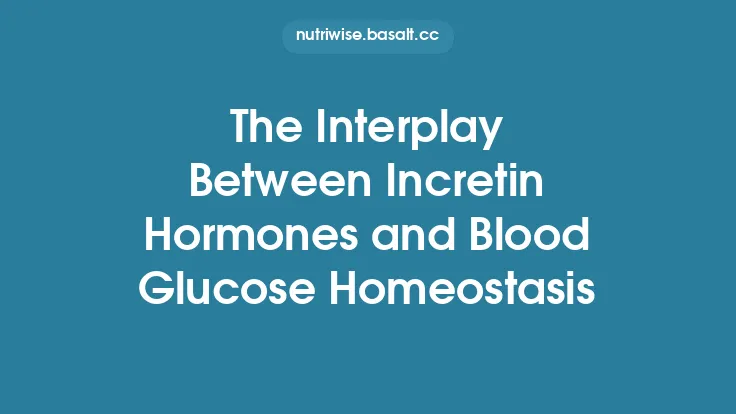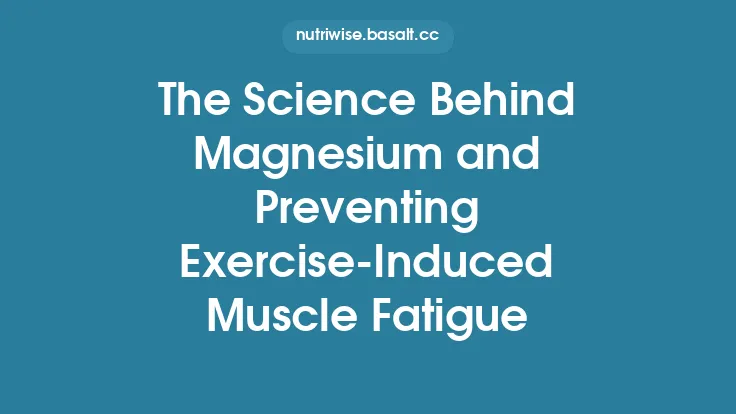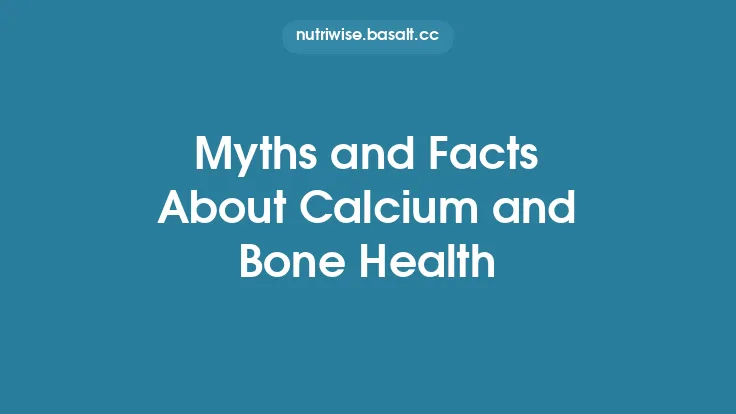Calcium and magnesium are two of the most abundant minerals in the human body, and together they account for a substantial proportion of skeletal mass. Their interplay is central to bone formation, remodeling, and maintenance of structural integrity throughout life. While calcium has long been recognized as the primary mineral component of hydroxyapatite crystals, magnesium’s role is more nuanced, influencing crystal size, solubility, and the activity of bone‑forming cells. Understanding how these minerals interact at the molecular, cellular, and systemic levels provides insight into optimal nutrition strategies for bone health and informs clinical approaches to osteoporosis, fracture risk, and metabolic bone diseases.
Physiological Roles of Calcium and Magnesium in Bone
Calcium’s structural function
- Forms the crystalline lattice of hydroxyapatite (Ca₁₀(PO₄)₆(OH)₂), providing rigidity and resistance to compressive forces.
- Approximately 99 % of total body calcium resides in bone, acting as a reservoir that can be mobilized to maintain serum calcium homeostasis.
Magnesium’s modulatory function
- Substitutes for calcium in the hydroxyapatite lattice at a ratio of roughly 1 %–5 % of total mineral content, altering crystal morphology and reducing lattice strain.
- Influences the activity of osteoblasts (bone‑forming cells) and osteoclasts (bone‑resorbing cells) through enzymatic co‑factor roles, particularly for ATP‑dependent processes and signaling kinases.
- Regulates parathyroid hormone (PTH) secretion and vitamin D metabolism, thereby indirectly affecting calcium balance.
Molecular Mechanisms of Interaction
1. Crystal Nucleation and Growth
Magnesium ions (Mg²⁺) compete with calcium ions (Ca²⁺) during the nucleation phase of hydroxyapatite formation. Mg²⁺ has a smaller ionic radius (0.72 Å) and higher hydration energy than Ca²⁺ (1.00 Å), which leads to:
- Inhibition of crystal growth: Mg²⁺ adsorbs onto nascent crystal faces, hindering further Ca²⁺ incorporation and resulting in smaller, more soluble crystals.
- Stabilization of amorphous calcium phosphate (ACP): Elevated Mg²⁺ levels favor the persistence of ACP, a precursor that can be remodeled into mature hydroxyapatite under controlled conditions.
2. Enzymatic Cofactor Activity
Magnesium is an essential co‑factor for several enzymes directly involved in bone metabolism:
- Alkaline phosphatase (ALP): Mg²⁺ is required for optimal ALP activity, which hydrolyzes pyrophosphate, a potent inhibitor of mineralization.
- ATP‑dependent kinases: Mg‑ATP complexes drive signaling cascades (e.g., MAPK, Wnt/β‑catenin) that regulate osteoblast differentiation and function.
- Matrix metalloproteinases (MMPs): Mg²⁺ modulates MMP activity, influencing extracellular matrix remodeling during bone turnover.
3. Hormonal Crosstalk
The calcium–magnesium axis intersects with endocrine regulators:
- Parathyroid hormone (PTH): Low serum calcium triggers PTH release, which stimulates renal calcium reabsorption and bone resorption. Magnesium deficiency blunts PTH secretion and reduces target‑organ responsiveness, potentially leading to hypocalcemia despite adequate calcium intake.
- Calcitonin: This thyroid‑derived hormone lowers serum calcium by inhibiting osteoclast activity; magnesium status can affect calcitonin release, though the relationship is less pronounced than with PTH.
- 1,25‑Dihydroxyvitamin D (calcitriol): Magnesium is required for the hepatic 25‑hydroxylation and renal 1α‑hydroxylation steps that generate active vitamin D, which in turn enhances intestinal calcium absorption.
4. Cellular Signaling Pathways
- Wnt/β‑catenin pathway: Mg²⁺ enhances Wnt signaling, promoting osteoblast proliferation and matrix production. Calcium influx through voltage‑gated calcium channels also activates this pathway, creating a synergistic effect.
- TRPV5/6 channels: These calcium‑selective channels are modulated by intracellular Mg²⁺ levels, influencing calcium entry into osteoblasts and the subsequent activation of calcium‑dependent transcription factors (e.g., NFATc1).
- AMP‑activated protein kinase (AMPK): Mg²⁺ availability affects AMPK activity, which can shift the balance between bone formation and resorption by altering energy metabolism in bone cells.
Dietary Sources, Bioavailability, and Interaction in the Gut
Calcium sources
- Dairy products (milk, cheese, yogurt) provide highly bioavailable calcium (~30‑35 % absorption).
- Leafy greens (kale, bok choy) and fortified plant milks contribute additional calcium, though oxalates and phytates can reduce absorption.
Magnesium sources
- Whole grains, nuts, seeds, legumes, and dark‑green vegetables are rich in magnesium.
- The typical dietary magnesium absorption rate is 30‑50 %, influenced by intestinal pH, presence of dietary fiber, and concurrent mineral intake.
Interaction during absorption
- Both minerals share common transport mechanisms (e.g., paracellular diffusion driven by electrochemical gradients). High luminal concentrations of one can competitively inhibit the other's uptake, especially when intake exceeds physiological needs.
- However, moderate co‑consumption often yields a balanced Ca:Mg ratio (commonly recommended between 1.5:1 and 2:1) that supports optimal bone mineralization without significant antagonism.
Clinical Implications and Nutritional Recommendations
Osteoporosis Prevention
- Epidemiological data consistently link adequate calcium intake (1,000‑1,200 mg/day for adults) with reduced fracture risk.
- Magnesium intake of 300‑420 mg/day (depending on age and sex) is associated with higher bone mineral density (BMD) and lower incidence of osteoporotic fractures.
- Interventions that simultaneously address both minerals—through diet or combined supplementation—show greater improvements in BMD than calcium alone.
Managing Hypocalcemia and Hypomagnesemia
- In patients with chronic hypomagnesemia, calcium supplementation alone may be ineffective because low Mg²⁺ impairs PTH secretion and vitamin D activation.
- Correcting magnesium status first often normalizes calcium homeostasis and reduces the need for high‑dose calcium therapy.
Supplementation Strategies
- Balanced multi‑mineral formulas: Products containing calcium carbonate or citrate with magnesium oxide or citrate in a Ca:Mg ratio of ~2:1 are widely used.
- Timing considerations: Splitting doses (e.g., calcium with meals, magnesium in the evening) can minimize competition for intestinal transporters and improve overall absorption.
- Form selection: Calcium citrate is less dependent on gastric acidity than calcium carbonate, while magnesium glycinate offers higher bioavailability and fewer laxative effects.
Special Populations
- Postmenopausal women: Estrogen deficiency accelerates bone loss; ensuring adequate magnesium may mitigate the heightened osteoclastic activity.
- Elderly men: Age‑related decline in renal magnesium reabsorption necessitates careful monitoring to avoid subclinical deficiency.
- Athletes: Intense training increases urinary calcium and magnesium losses; tailored nutrition plans should address both minerals to preserve bone integrity.
Future Research Directions
- Genomic and Metabolomic Profiling – Investigating how genetic polymorphisms in calcium‑ and magnesium‑transport proteins (e.g., TRPV5, CNNM2) influence individual responses to dietary intake.
- Nanostructural Imaging – Advanced synchrotron‑based techniques can visualize how varying Mg²⁺ concentrations affect hydroxyapatite crystal orientation and mechanical properties at the nanoscale.
- Microbiome‑Mediated Modulation – While the gut microbiota’s role in fiber metabolism is well documented, emerging data suggest certain bacterial taxa can alter mineral solubility and transport, offering a potential avenue for probiotic‑based bone health interventions.
- Longitudinal Intervention Trials – Large‑scale, double‑blind studies comparing calcium‑only versus calcium‑plus‑magnesium supplementation on fracture outcomes will clarify the additive benefit of magnesium.
- Systems Biology Models – Integrating hormonal, cellular, and nutritional data into computational models could predict optimal Ca:Mg ratios for different life stages and disease states.
Concluding Perspective
The relationship between calcium and magnesium in bone metabolism exemplifies a classic nutrient interaction where one mineral provides the structural backbone while the other fine‑tunes the architecture and regulatory environment. Their synergistic actions—ranging from crystal formation to hormonal signaling—underscore the importance of maintaining a balanced dietary intake. Clinicians and nutrition professionals should assess both calcium and magnesium status when addressing bone health, recognizing that deficiencies or excesses of either can disrupt the delicate equilibrium required for robust skeletal function. By embracing an integrated, evidence‑based approach to calcium‑magnesium nutrition, we can better support lifelong bone integrity and reduce the burden of metabolic bone diseases.





